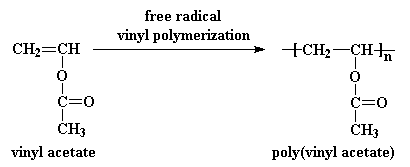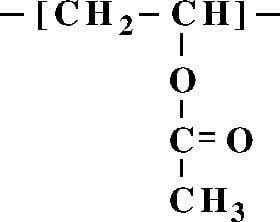Formula (C4H6O2)n Density 1.19 g/cm³ | Molar mass 86.09 g/mol | |
IUPAC ID poly (1-acetyloxiethylene) | ||
Polyvinyl acetate
Poly(vinyl acetate) (PVA, PVAc, poly(ethenyl ethanoate): commonly referred to as wood glue, white glue, carpenter's glue, school glue, Elmer's glue in the US, or PVA glue) is an aliphatic rubbery synthetic polymer with the formula (C4H6O2)n. It belongs to the polyvinyl esters family, with the general formula -[RCOOCHCH2]-. It is a type of thermoplastic.
Contents

Pva film
Properties

The degree of polymerization of poly(vinyl acetate)(which creates a reaction with certain boron based minerals) is typically 100 to 5000, while its ester groups are sensitive to base hydrolysis and slowly convert PVAc into polyvinyl alcohol and acetic acid.

Under alkaline conditions, boron compounds such as boric acid or borax cause the polymer to cross-link, forming tackifying precipitates or toys, such as Slime and Flubber.
A number of microorganisms can degrade polyvinyl acetate. Most commonly, damage is caused by filamentous fungi—however algae, yeasts, lichens, and bacteria can also degrade polyvinyl acetate.
Discovery
Poly(vinyl acetate) was discovered in Germany in 1912 by Fritz Klatte.
The monomer, vinyl acetate, was first produced on an industrial scale by the addition of acetic acid to acetylene with a mercury(I) salt but it is now primarily made by palladium catalyzed oxidative addition of acetic acid to ethylene.
Preparation
PVAc is a vinyl polymer. Polyvinyl acetate is prepared by the polymerization of vinyl acetate monomer (free radical vinyl polymerization of the monomer vinyl acetate).
Applications
As an emulsion in water, PVAc emulsions are used as adhesives for porous materials, particularly for wood, paper, and cloth, and as a consolidant for porous building stone, in particular sandstone. Uses:
The stiff homopolymer PVAc, but mostly the more soft copolymer, a combination of vinyl acetate and ethylene, vinyl acetate ethylene (VAE), is also used in paper coatings, paint and other industrial coatings, as a binder in nonwovens in glass fibers, sanitary napkins, filter paper and in textile finishing.
Polyvinyl acetate is also the raw material to make other polymers like:
